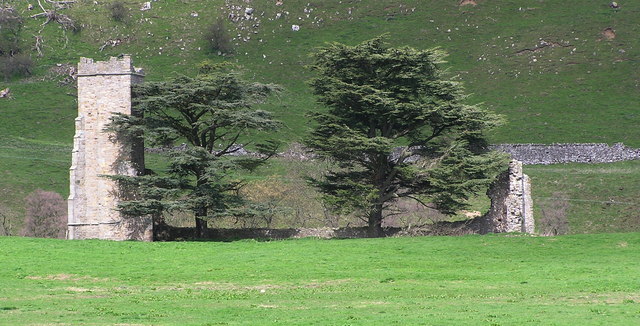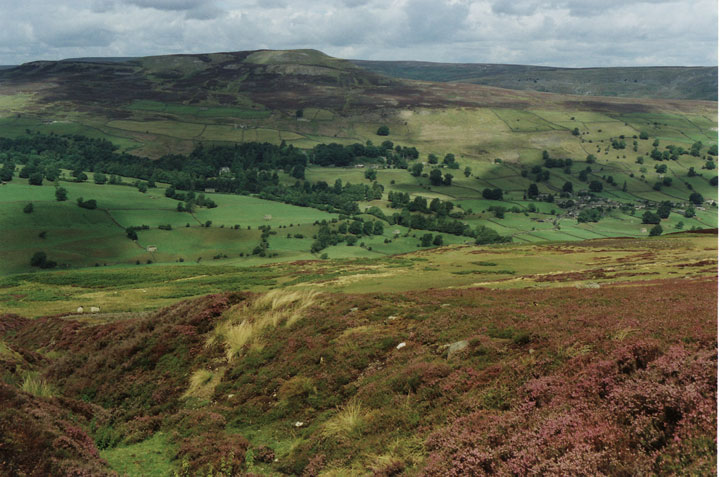|
Joan Harkey
Joan Harkey ( – 1550) was the last English prioress of Ellerton Priory in Swaledale in Yorkshire. Life There is some confusion over who founded the priory but it was established, probably, in the twelfth century. The candidates are the Egglescliffe family, Warnerus, chief steward to the Earl of Richmond, or by Wymerus of the Aske family. Another candidate was William Aslaby and one of his descendants may have included Agnes Aslaby who was one of the last nuns in the priory. Agnes was one of six nuns in the convent and another was Joan Harkey who was from a similar background. Details of Harkey's birth and early life are unknown, but at some point she was promoted from nun to prioress. In 1536 Cromwell's commissioners arrived to inspect the convent as part of the Dissolution of the Monasteries. Harkey had to admit that one of her nuns, Cecily Swale, was asking to leave the convent. She wanted to leave after being released from her vows, but she had already given birth to at ... [...More Info...] [...Related Items...] OR: [Wikipedia] [Google] [Baidu] |
Ellerton Priory (Swaledale)
Ellerton Priory was a priory of Cistercian nuns in Swaledale in North Yorkshire, England. Its ruins lie in the civil parish of Ellerton Abbey. History There is uncertainty over the establishment of the priory. It was probably founded in the late 12th century, either by the Egglescliffe family, or by Warnerus, chief steward to the Earl of Richmond, or by Wymerus of the Aske family. In 1342 it suffered badly at the hands of marauding Scots, who are described as having razed and despoiled the Priory. In 1536 Thomas Cromwell's commissioners arrived to inspect the convent as part of the Dissolution of the Monasteries. The prioress Joan Harkey had to admit that one of her nuns, Cecily Swale, was asking to leave the convent. She wanted to leave after being released from her vows, but she had already given birth to a child. Not every monastery was to be closed in this phase, but the priory was formally surrendered to the Crown in August that year and dissolved in the following ye ... [...More Info...] [...Related Items...] OR: [Wikipedia] [Google] [Baidu] |
Kingdom Of England
The Kingdom of England (, ) was a sovereign state on the island of Great Britain from 12 July 927, when it emerged from various Anglo-Saxon kingdoms, until 1 May 1707, when it united with Scotland to form the Kingdom of Great Britain. On 12 July 927, the various Anglo-Saxon kings swore their allegiance to Æthelstan of Wessex (), unifying most of modern England under a single king. In 1016, the kingdom became part of the North Sea Empire of Cnut the Great, a personal union between England, Denmark and Norway. The Norman conquest of England in 1066 led to the transfer of the English capital city and chief royal residence from the Anglo-Saxon one at Winchester to Westminster, and the City of London quickly established itself as England's largest and principal commercial centre. Histories of the kingdom of England from the Norman conquest of 1066 conventionally distinguish periods named after successive ruling dynasties: Norman (1066–1154), Plantagenet (1154–1485), Tudor ... [...More Info...] [...Related Items...] OR: [Wikipedia] [Google] [Baidu] |
Swaledale
Swaledale is one of the northernmost dales (valleys) in Yorkshire Dales National Park, located in northern England. It is the dale of the River Swale on the east side of the Pennines in North Yorkshire. Geographical overview Swaledale runs broadly from west to east, from the high moors on the Cumbria–Yorkshire boundary at the watershed of Northern England to the market town of Richmond, where the dale meets the lowlands. Nine Standards Rigg, the prominent ridge with nine ancient tall cairns, rises on the watershed at the head of Swaledale. To the south and east of the ridge a number of smaller dales (Birkdale, Little Sleddale, Great Sleddale and Whitsundale) join to form the narrow valley of upper Swaledale at the small village of Keld. From there, the valley runs briefly south then turns east at Thwaite to broaden progressively as it passes Muker, Gunnerside, Low Row, Healaugh and Reeth. The Pennine valley ends at Richmond, where an important medieval castle sti ... [...More Info...] [...Related Items...] OR: [Wikipedia] [Google] [Baidu] |
Earl Of Richmond
The now-extinct title of Earl of Richmond was created many times in the Peerage of England. The earldom of Richmond was initially held by various Breton nobles; sometimes the holder was the Breton duke himself, including one member of the cadet branch of the French Capetian dynasty. The historical ties between the Duchy of Brittany and this English earldom were maintained ceremonially by the Breton dukes even after England ceased to recognize the Breton dukes as earls of England and those dukes rendered homage to the King of France, rather than the English crown. It was then held either by members of the English royal families of Plantagenet and Tudor, or English nobles closely associated with the English crown. It was eventually merged into the English crown during the reign of Henry VII of England and has been recreated as a Dukedom. History The title Earl of Richmond is associated with the now extinct earldom, the earlier lords of Richmond who held the Honour of Richmond, ... [...More Info...] [...Related Items...] OR: [Wikipedia] [Google] [Baidu] |
Ellerton Priory (1)
{{disambiguation, geo ...
Ellerton Priory may refer to *Ellerton Priory (Swaledale), a ruined priory in North Yorkshire, England * Ellerton Priory (Spalding Moor), a former priory in the East Riding of Yorkshire, England * Ellerton Priory (parish), a civil parish in the East Riding of Yorkshire, England, abolished in 1935 to form part of Ellerton, East Riding of Yorkshire *Ellerton Priory Church, a redundant church at Ellerton, East Riding of Yorkshire, England See also *Ellerton Abbey Ellerton Abbey is a civil parish in the Richmondshire district of North Yorkshire, England. It is located on the River Swale in lower Swaledale, south-west of Richmond. The population of the parish was estimated at 20 in 2016. The parish c ... [...More Info...] [...Related Items...] OR: [Wikipedia] [Google] [Baidu] |
Grade II
In the United Kingdom, a listed building or listed structure is one that has been placed on one of the four statutory lists maintained by Historic England in England, Historic Environment Scotland in Scotland, in Wales, and the Northern Ireland Environment Agency in Northern Ireland. The term has also been used in the Republic of Ireland, where buildings are protected under the Planning and Development Act 2000. The statutory term in Ireland is "Record of Protected Structures, protected structure". A listed building may not be demolished, extended, or altered without special permission from the local planning authority, which typically consults the relevant central government agency, particularly for significant alterations to the more notable listed buildings. In England and Wales, a national amenity society must be notified of any work to a listed building which involves any element of demolition. Exemption from secular listed building control is provided for some buildin ... [...More Info...] [...Related Items...] OR: [Wikipedia] [Google] [Baidu] |
1550 Deaths
Year 155 ( CLV) was a common year starting on Tuesday (link will display the full calendar) of the Julian calendar. At the time, it was known as the Year of the Consulship of Severus and Rufinus (or, less frequently, year 908 ''Ab urbe condita''). The denomination 155 for this year has been used since the early medieval period, when the Anno Domini calendar era became the prevalent method in Europe for naming years. Births * Cao Cao, Chinese statesman and warlord (d. 220) * Dio Cassius, Roman historian (d. c. 235) * Tertullian, Roman Christian theologian (d. c. 240) * Sun Jian, Chinese general and warlord (d. 191) Deaths * Pius I, Roman bishop * Polycarp, bishop of Smyrna (b. AD 65 AD 65 ( LXV) was a common year starting on Tuesday (link will display the full calendar) of the Julian calendar. At the time, it was known as the Year of the Consulship of Nerva and Vestinus (or, less frequently, year 818 ''Ab urbe condita''). ...) References {{DEFAULTSORT:155 [...More Info...] [...Related Items...] OR: [Wikipedia] [Google] [Baidu] |
Priors
Prior (or prioress) is an ecclesiastical title for a superior in some religious orders. The word is derived from the Latin for "earlier" or "first". Its earlier generic usage referred to any monastic superior. In abbeys, a prior would be lower in rank than the abbey's abbot or abbess. Monastic superiors In the Rule of Saint Benedict, the term appears several times, referring to any superior, whether an abbot, provost, dean, etc. In other old monastic rules the term is used in the same generic sense. With the Cluniac Reforms, the term ''prior'' received a specific meaning; it supplanted the provost or dean (''praepositus''), spoken of in the Rule of St. Benedict. The example of the Cluniac congregations was gradually followed by all Benedictine monasteries, as well as by the Camaldolese, Vallombrosians, Cistercians, Hirsau congregations, and other offshoots of the Benedictine Order. Monastic congregations of hermit origin generally do not use the title of abbot for th ... [...More Info...] [...Related Items...] OR: [Wikipedia] [Google] [Baidu] |




